Planning a weekend in Madrid? This 2-day Madrid itinerary is perfect if you’re visiting for the first time. It includes where to stay, where to eat, what to do, and how to make the most of your trip.
While not as popular as Barcelona, going to the capitol city of Spain is worth visiting to get a taste of real Spanish cuisine, art, and culture.
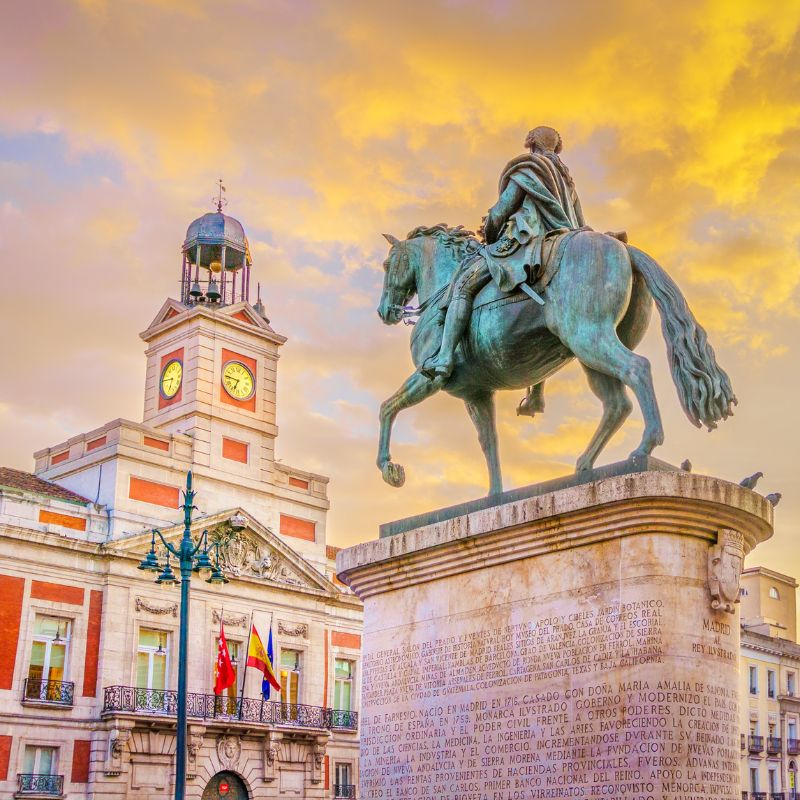
Table of Contents
Things to know before traveling to Madrid
When is the best time to go? The best time to visit Madrid is in the spring (March to May) and in the fall (September to November) when the weather is mild and there are fewer crowds.
Where is the best area to stay? You’ll want to stay in a central location since most of the main landmarks and attractions are close together.
The best neighborhoods to book your accommodations are Centro, Sol, La Latina, Huertas, Barrio de las Letras, Malasaña, and Salamanca.
I’ve stayed in the Sol and Malasaña neighborhood and loved both spots. Sol is perfect for first-timers and Malasaña is great for restaurants and bars.
What are the top 5 things to do in Madrid: Prado National Museum (the main art museum in Madrid), Santiago Bernabéu Stadium (football stadium in Madrid), The Palacio Real (Royal Palace of Madrid), Museo Nacional Thyssen-Bornemisza (a popular art museum in Madrid), and to see a Flamenco show.
Best way to save money on attractions: Use the Madrid Pass. You can save up to 50% on the city’s most popular attractions and tours with this pass.
Choose the All-Inclusive Madrid Pass, which allows you to visit unlimited attractions each day of your pass.
Or you can choose the Explorer Madrid Pass, which allows you to select how many attractions you want to visit (3, 4, 5, 6, or 7).
FLASH SALE! Save up to 10% off the Madrid Pass. Offer ends July 21st. You have 2 years to activate the pass.
What is the best way to get around Madrid? Riding the metro and public bus is the fastest and easiest way to get around Madrid. If you’re staying in a central location like Centro or Sol, you can visit most of the city’s top attractions and landmarks on foot.
If you prefer to be comfortable and relax, you can ride the Hop-On Hop-Off Bus Tour, which is a great way to get familiar with Madrid for first-timers.
What is Madrid famous for? Madrid is known for its stunning historical buildings, the royals, tasty food markets, unique neighborhoods, lively nightlife, and art museums.
What are the best hotels to stay at in Madrid?
Best budget hotels in Madrid:
Best mid-range hotels in Madrid:
- Hotel Mayorazgo (We stayed here and loved it!)
- Vincci Soho
- Hotel Cortezo
Best luxury hotels in Madrid:
- Hotel Palacio del Retiro, Autograph Collection
- Palacio de los Duques Gran Meliá
- The Westin Palace, Madrid
Check out hotel deals in Madrid below thanks for Booking.com. I used this site for my trip to find the best price!
Booking.comTop 10 things to do in Madrid
According to TripAdvisor, below are the top 10 things to see and do in Madrid.
- Parque del Retiro
- Prado National Museum
- Royal Palace of Madrid
- Museo Nacional Thyssen-Bornemisza
- Gran Via
- Plaza Mayor
- Santiago Bernabéu Stadium
- Museo Nacional Centro de Arte Reina Sofía
- Mercado San Miguel
- Museo Arqueologico Nacional
Most of these attractions are included for free when you buy the Madrid Pass. This can save you up to 50% off entry compared to purchasing individual tickets.
Day 1 in Madrid – Santiago Bernabéu Stadium, Royal Palace, Parque del Retiro
Today you will take a tour of the second largest football stadium in Spain, see the official residence of the Spanish royal family, and explore one of the largest parks in the city of Madrid.
Start off your morning by grabbing breakfast at one of the popular spots for churros in the city.
Churrería Chocolateria 1902 and Chocolatería San Ginés are the most well-known establishments.
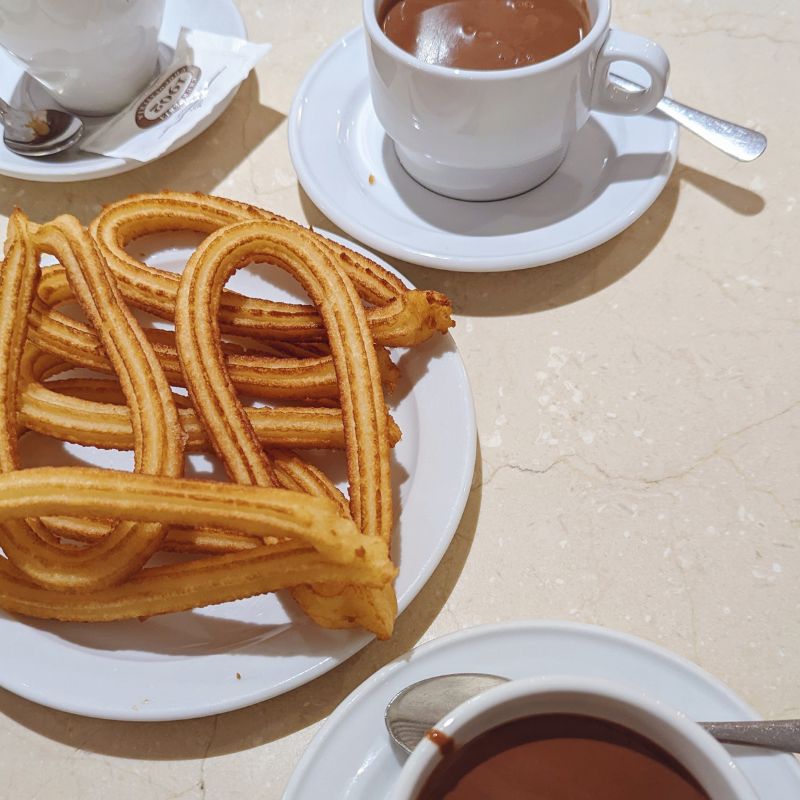
Chocolatería San Ginés tends to get busier, so if you have trouble getting a table, Churrería Chocolateria 1902 is just around the corner (a 2-minute walk away).
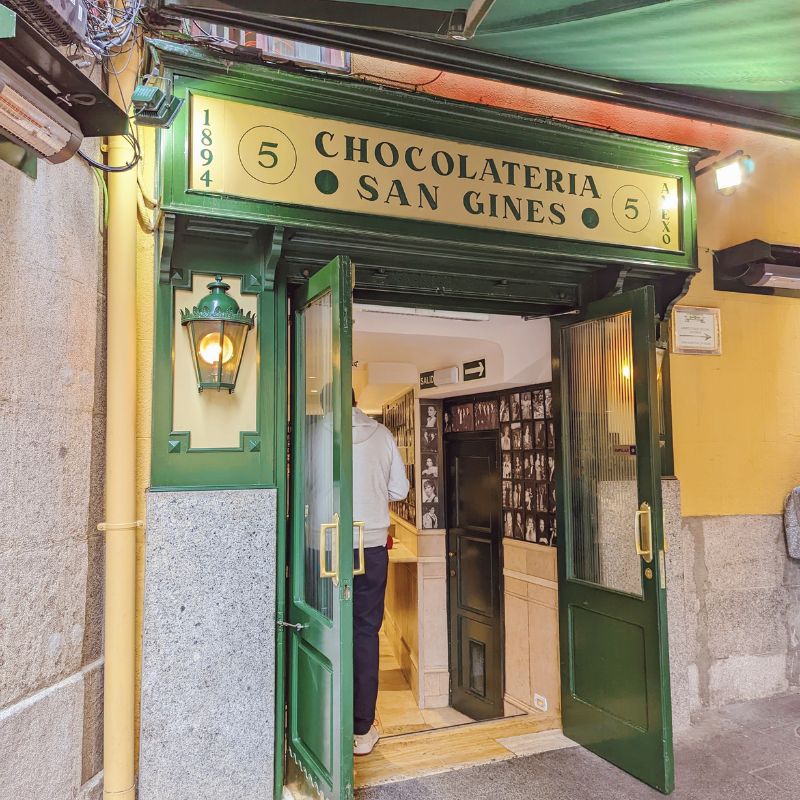
Both places are good, and their chocolate and churros are delicious. If you’ve never had Spanish churros before, the traditional way to enjoy them is to dip your churro in a mug of hot chocolate.
If you’re using the Madrid Pass, you can enjoy a 1-hour Segway tour of the city and end the tour with chocolate and churros.
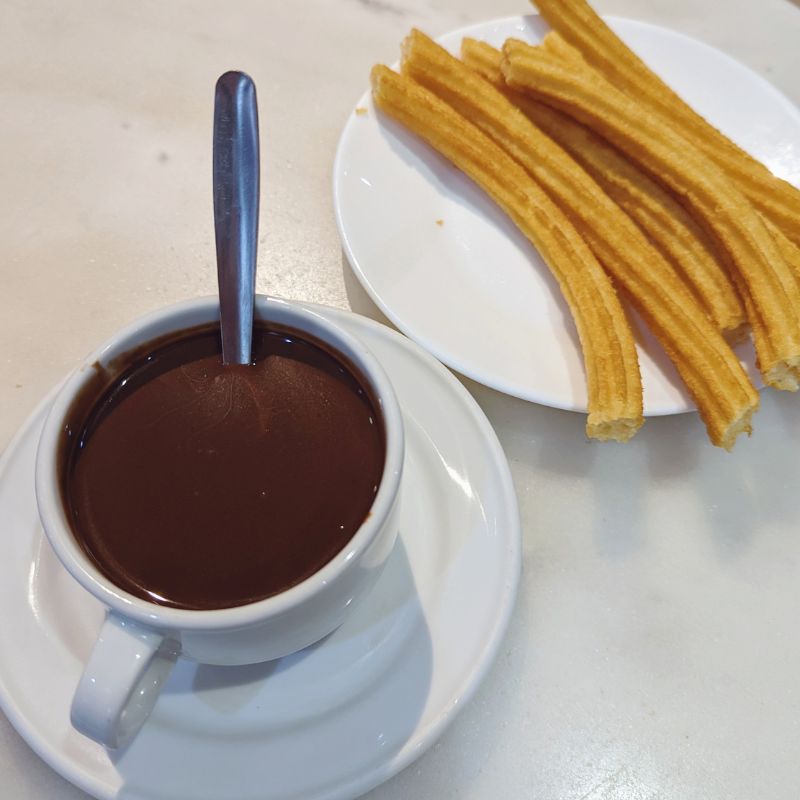
Santiago Bernabéu Stadium
If you’re a big football fan, then you’ll want to do a Santiago Bernabéu Stadium tour. This has been home to the stadium of Real Madrid since 1947 and is one of the biggest football clubs in the world.
Football is the most popular sport in Spain, so it’s no surprise that over one million fans visit Santiago Bernabéu Stadium every year.
I recommend booking your tickets online in advance to avoid waiting in a long queue, especially during peak season.
The stadium tour takes around 45 minutes to complete, but you are welcome to stay for as long as you’d like.
The best way to get to Santiago Bernabéu Stadium is by the metro. Take the Metro Line 10 which stops right next to the stadium at Santiago Bernabeu station.
If you’re using the Madrid Pass, you can enjoy a Bernabeu Stadium Tour for free.
FLASH SALE! Save up to 10% off the Madrid Pass. Offer ends July 18th. You have 2 years to activate the pass.
Museo Arqueologico Nacional
The National Archaeological Museum, also known as MAN, is a great space where you can learn about history from ancient civilizations to present day.
The museum is located in the Salamanca neighborhood of Madrid. If you’re traveling here by metro, you can take Line 4 to Serrano station or Line 2 to Retiro station.
If you’re on a budget, you can visit the museum for free on Saturday afternoons (after 2:00pm) or Sunday mornings. Keep in mind that these are the busiest times to visit the museum.
Plan to spend the most time exploring the main floor here which has most of the major sculptures. If you’re a history buff, then you’ll want to check out the upstairs sections as well, which could easily take you a few hours.
Parque del Retiro
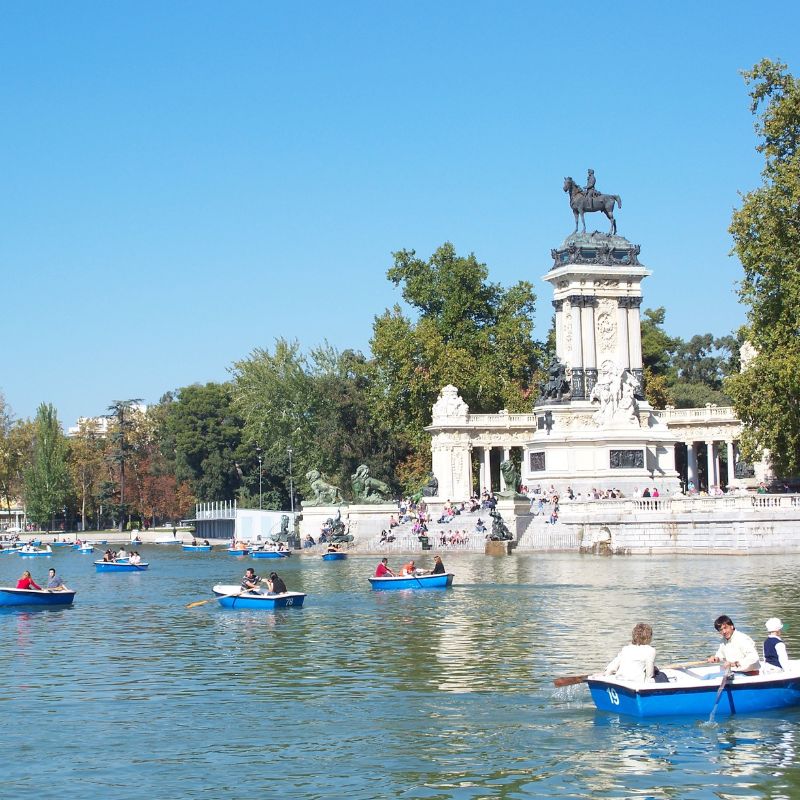
After visiting the museum, it’s time to get some lunch and head to El Retiro Park. There is a café located in the museum, but I prefer to grab food at Honest Greens.
This is a casual restaurant that serves healthy and delicious food for an affordable price. You can enjoy your meal there or take it to-go and have a picnic in the park.
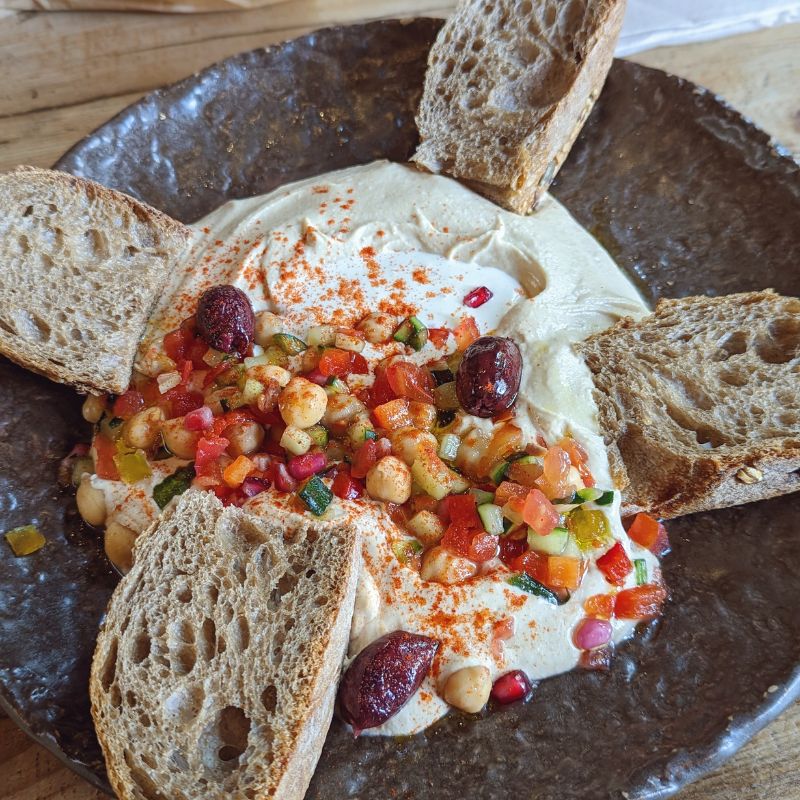
This is one of the largest parks located in the heart of Madrid. It belonged to the Spanish Monarchy until the late 19th century when it became a public park for everyone to enjoy.
This was one of my favorite free things to do during our trip to Madrid. The most popular thing to do here is to check out the massive monument to King Alfonso XII.
It surrounds an artificial lake on the east side of the park where you can rent rowboats.
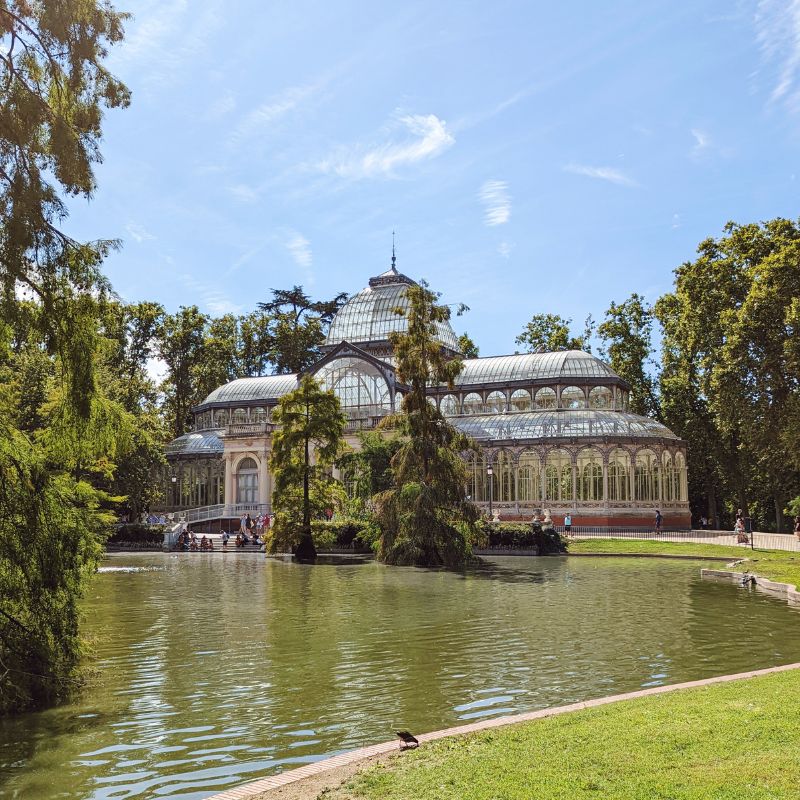
Some other highlights of the park include:
- Fuente Egipcia, which is a sculpture decorated with sphinxes.
- El Angel Caído (The Fallen Angel), which apparently is the only artistic statue in the world depicting Lucifer.
- The ruins of Ermita de San Pelayo y San Isidro.
- Palacio de Cristal (Glass Palace).
- The oldest tree in Madrid which was planted in 1633.
- La Rosaleda Garden, which has over 4,000 roses in bloom during the summer months.
Royal Palace of Madrid
The Royal Palace is the most popular tourist attraction in Madrid, so if you have your heart set on visiting this place, you’ll want to book your tickets in advance.
Tickets are limited and often sell out quickly, so you can avoid disappointment by securing your preferred time and date for your tickets online.
If you don’t buy your tickets in advance, you may find yourself waiting 1-2 hours on any given day before gaining entry access.
The Royal Palace is the official residence for the Royal family, but it’s currently only used for state ceremonies and open for the public to visit.
It consists of more than 3,000 rooms spread out across six floors.
If you’re using the Madrid Pass, you can enjoy a guided tour of the Royal Palace for free.
Highlights of this tour include the Throne room, Royal Armory, Old masters, and Campo del Moro.
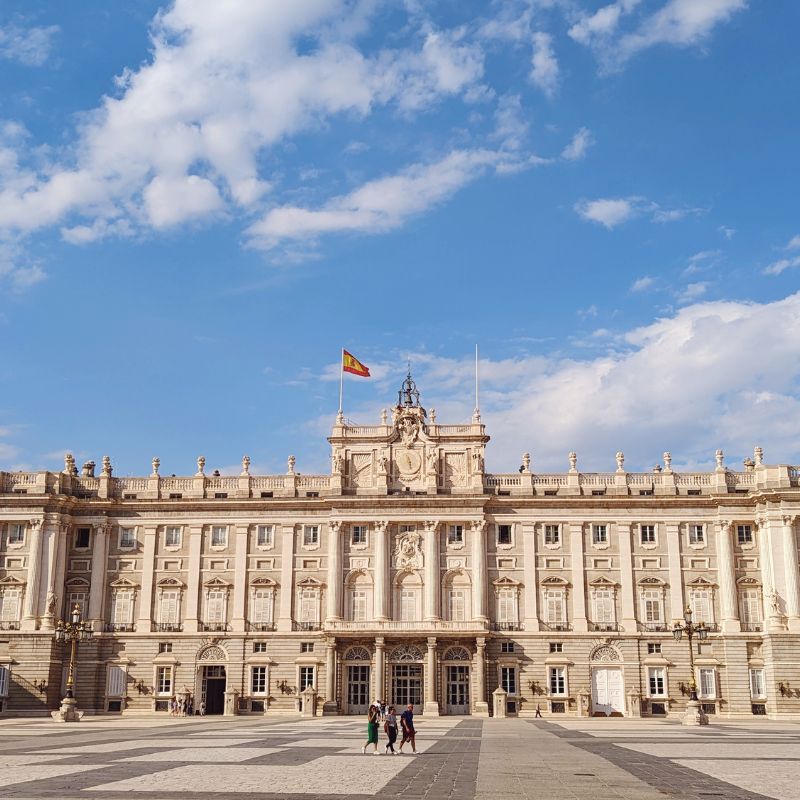
Which ticket should you buy? You have a choice of purchasing either a skip-the-line entrance ticket (self-guided) or a ticket for a guided tour of the palace.
If you’re interested in learning more about the palace, the guided tour will provide an in-depth experience, which lasts approximately 45 minutes. Guided tour tickets by default allow you to skip the line.
Otherwise, you can take a self-guided tour of the palace which includes information points throughout that explain more about each room.
How to get to the Royal Palace of Madrid – You can take the metro and get off at Ópera, which is the closest station to the palace. It’s about a 5-minute walk from the station to the entrance of the palace.
You can also ride the Hop-On Hop-Off bus tour, which will stop at the popular sites in Madrid, including the Royal Palace.
Mercado San Miguel
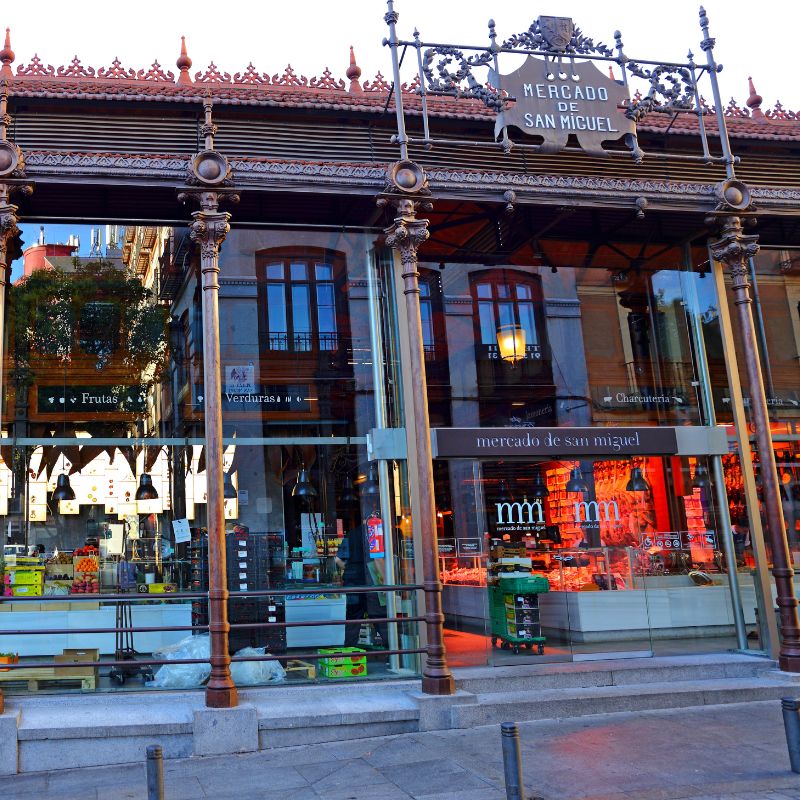
San Miguel Market is a local food market in Madrid that opened back in 1916. Over 10 million people visit this gourmet food market per year, so you’ll definitely want to include this on your itinerary.
After exploring the Royal Palace, this is a great spot to grab a drink and enjoy Spanish tapas.
It can get quite busy during meal times (especially on the weekends), so walk around to scope out everything before you pick a place to grab a bite.
If you’re looking for an authentic place to have tapas in Madrid, I recommend checking out Casa Toni, which is about a 9-minute walk from San Miguel Market.
It doesn’t look like much from the outside, but it’s a popular spot with the locals to enjoy generous portions of delicious Spanish food and drink at an affordable price.
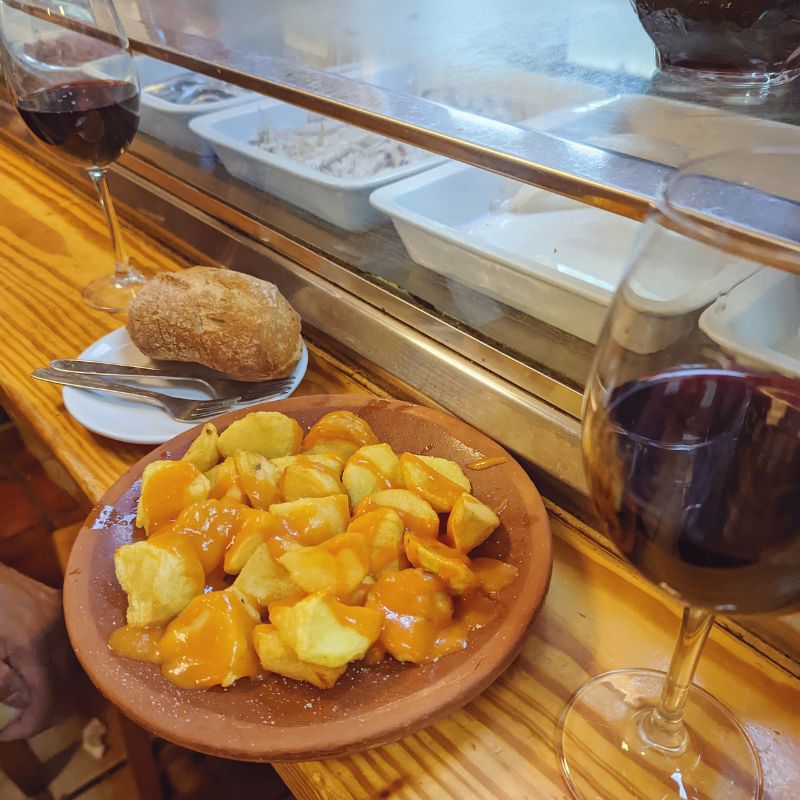
Day 2 in Madrid – Art Museums, Gran Via, Plaza Mayor
Madrid is one of the best cities in Spain for art lovers.
Today is your opportunity to check out the “big three” art museums in Madrid, shop along the street that never sleeps, and check out Plaza Mayor which is the heart and epicenter of Madrid life.
Prado National Museum
The Prado Museum is the most popular art museum in Madrid and a goldmine for anyone who loves art. This museum houses the most comprehensive collection of Spanish paintings in the world.
The collection of art ranges from the 12th to the 20th centuries with the most famous works being “Las Meninas” by Diego Velazquez and “Third of May 1808” by Francisco Goya.
Since the museum is home to over 20,000 works of art, you can easily spend up to 3 hours exploring the museum. However, if you’re short on time, check out the following exhibits:
- Francisco Goya’s La Maja desnuda
- Diego Velázquez’s Las Meninas
- Hieronymous Bosch’s triptych The Garden of Earthly Delights
- Raphael’s The Cardinal
- Titian’s Venus and Adonis
The Prado Museum is always busy, so it’s best to purchase your tickets in advance to skip the long queues.
If you’re using the Madrid Pass, you can enjoy a free guided tour of the Prado Museum (a €50.00 value).
Simply click the link to buy your pass. Then when you’ve finalized your itinerary, you can book your spot to visit on your preferred date and time.
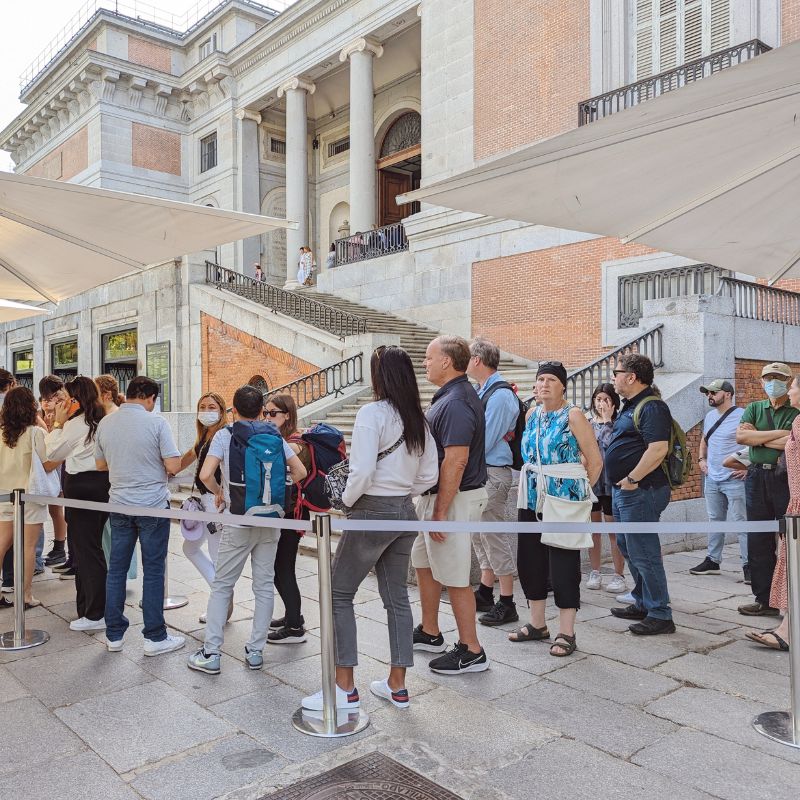
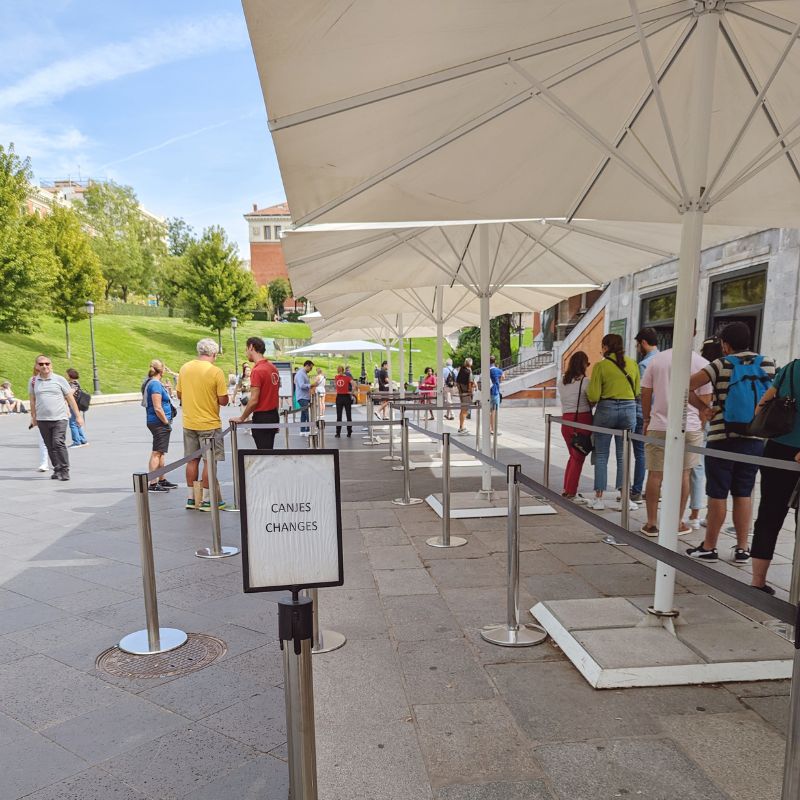
There’s also the option to take a guided tour is you’re a big fan of Spanish art, but we just purchased the regular skip-the-line entrance ticket.
How to purchase your tickets for the Prado Museum – You have a few different ticket options for your visit to the museum.
Skip-the-line Prado Museum entry ticket – This is a regular ticket that allows you to skip the queue and head straight inside the museum.
Skip-the-line Prado Museum guided tour – This is a popular option for those who want an in-depth experience and to learn more details about the famous masterpieces at the Prado Museum.
Paseo del Arte – If you’re planning to visit the main 3 art museums in Madrid – Prado Museum, Thyssen-Bornemisza Museum, and Reina Sofía Museum –then consider buying the Paseo del Arte pass.
This is valid for one year and allows you one visit to the permanent collection of each of the three museums.
When is the best time to visit the Prado Museum? The best time to visit is first thing in the morning when the museum opens, which is why I have it first on the list for Day 2 of this Madrid itinerary.
When can you visit the Prado Museum for free? The Prado Museum is free to visit between 6:00pm and 8:00pm (Monday to Saturday) and 5:00pm to 7:00pm (Sundays and public holidays).
While it may be tempting to visit during the free hours if you’re traveling on a budget, it gets extremely busy. You’ll usually find a HUGE line forming outside from over an hour before these free times.
So if you plan to visit during the free hours, come at least 60 minutes before the free time.
Gran Via
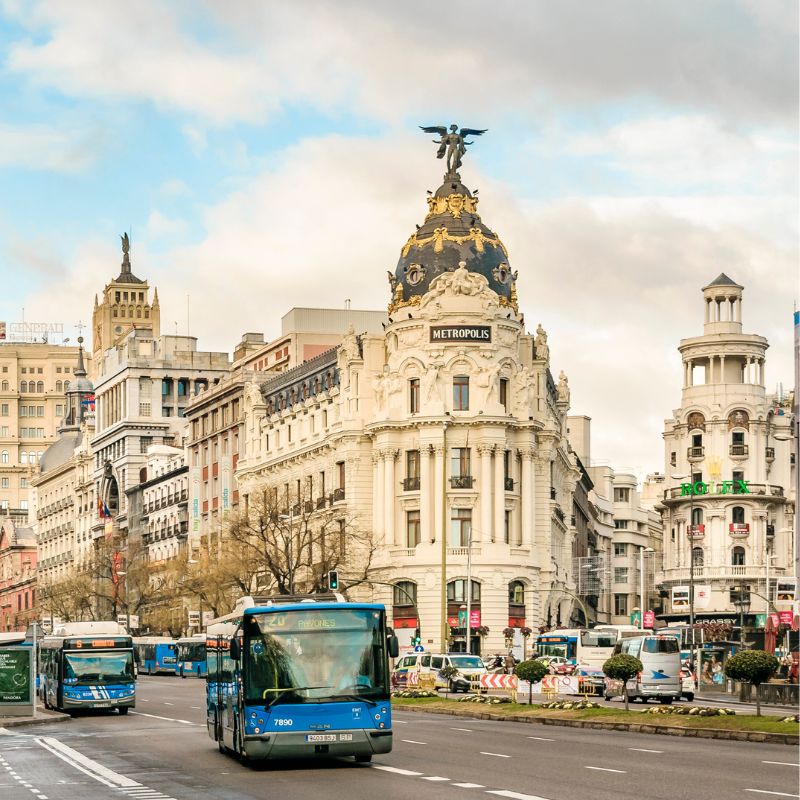
After exploring the Prado Museum, it’s time to grab lunch on Gran Via.
This is the most famous street in Madrid which connects Salamanca and Argüelles. The area is full of shops, restaurants, and some of the city’s most iconic buildings.
We enjoyed our lunch at Oven Mozzarella. They have an affordable 3-coure lunch menu (menú del día), which is perfect for a relaxing meal.
In Spain, the main (and biggest meal) of the day is at lunch time.
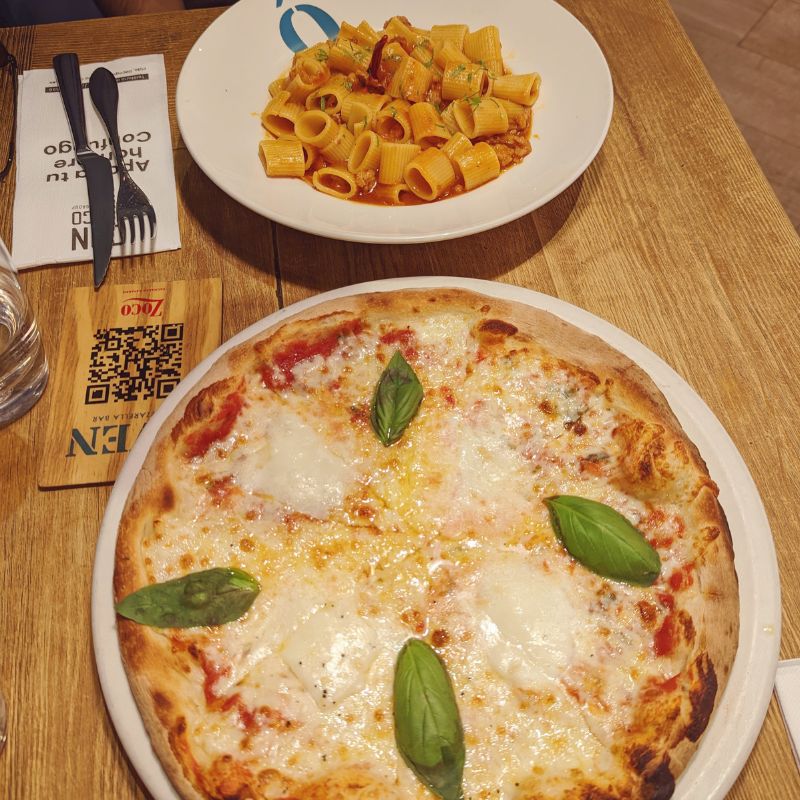
If you want a free view of Gran Via from above, head to the 9th floor of El Corte Inglés in Callao.
They also have options here to grab a drink and food if you want. I also like that El Corte Inglés offers free public bathrooms, which are hard to find in Madrid.
Museo Nacional Thyssen-Bornemisza
After lunch, it’s time to check out Thyssen-Bornemisza Museum, which is another popular art museum in the city.
The museum has the second-largest private collection in the world (second to the British Royal Collection). Here you can experience over 1,600 paintings from the 13th-20th centuries.
How to purchase your ticket for the Thyssen-Bornemisza Museum – You have a couple of options when visiting this museum.
You can buy a regular entrance ticket which allows you to skip-the-line or a guided tour ticket if you want a more in-depth experience.
Plan to spend at least 2-3 hours exploring the museum.
If you’re short on time, the most popular works of art to see at Thyssen-Bornemisza Museum are:
- “Venus and Cupid” – Peter Paul Rubens
- “Saint Catherine of Alexandria” – Caravaggio
- “Les Vessenots” in Auvers – Vincent van Gogh
- “Mata Mua (In Olden Times)” – Paul Gauguin
- “Portrait of a Peasant” – Paul Cézanne
- “Harlequin with a Mirror” – Pablo Picasso
- “Hotel Room” – Edward Hopper
- “Portrait of George Dyer in a Mirror” – Francis Bacon
If you’re using the Madrid Pass, you can enjoy free entry to Museo Nacional Thyssen-Bornemisza.
Museo Nacional Centro de Arte Reina Sofía
Reina Sofía is the third museum in Madrid’s “golden triangle” of art that’s dedicated to modern and contemporary art.
Since this is another popular attraction, you’ll want to buy your tickets in advance to avoid waiting in a long queue. It’s closed on Tuesdays, so plan your visit accordingly.
You can purchase a skip-the-line entrance ticket or pay slightly more to take a guided tour.
Plan to spend at least two hours exploring the museum.
If you’re short on time, the most popular works of art to see at the Reina Sofía are:
- Un mundo – Ángeles Santos
- Tableau et tabouret avec œufs – Marcel Broodthaers
- Autorretrato cubista – Salvador Dalí
- Face of the Great Masturbator of Dalí Guernica, Pablo Picasso
- La table du musicien (The Musician’s Table) – Juan Gris
If you’re using the Madrid Pass, you can enjoy a free guided tour of Reina Sofía Museum (a €29.00 value).
Simply click the link to buy your pass. Then when you’ve finalized your itinerary, you can book your spot to visit on your preferred date and time.
Plaza Mayor
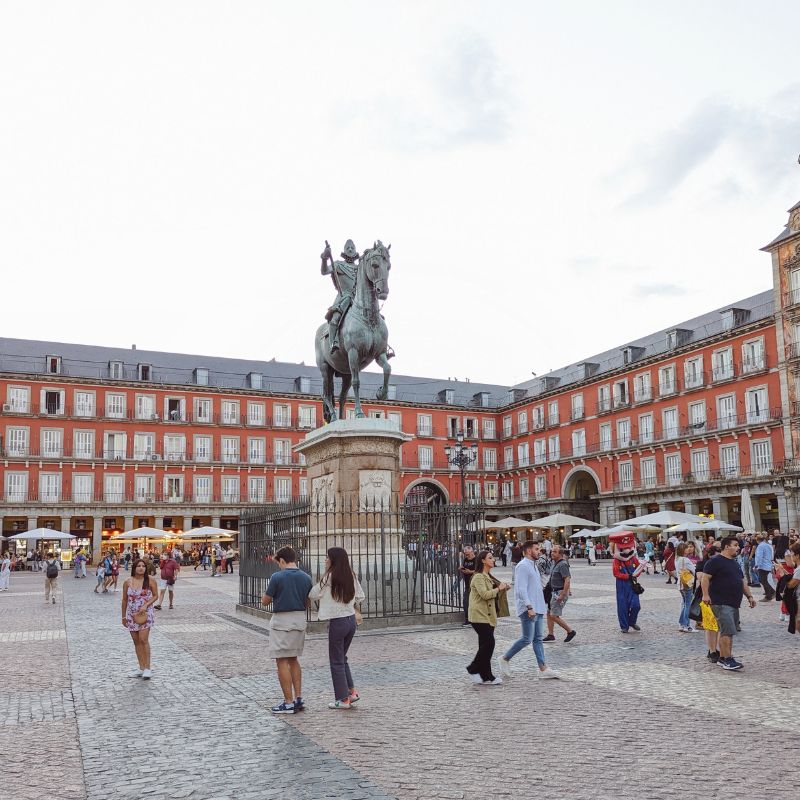
After a day of exploring the three popular art museums in Madrid, make your way to Plaza Mayor. This is Madrid’s grand central square in the oldest part of the city.
It was built between the 16th and 17th centuries with the equestrian statue of Phillip III in the center of the square. If you’re visiting during the holidays, Plaza Mayor hosts Madrid’s annual Christmas market.
Here you can find the oldest restaurant in Spain, Sobrino del Botin, which was established in 1725.
However, I don’t recommend eating at the restaurants in Plaza Mayor as they are mainly catered to tourists and can be overpriced.
But it can be a great spot to walk around, have a drink on the patio, and people watch before continuing to your next destination.
Flamenco show

Madrid is not only the capitol city of Spain, but it’s also the capitol of Flamenco. If this is your first visit to the city, you don’t want to miss your chance to see the world’s best Flamenco dancers.
Flamenco dancing is a Spanish art form which is highly expressive and based on the various folklore music traditions of southern Spain.
If you want to experience flamenco, these are the tops spots to do so in Madrid: Corral de la Morería (one of the most famous flamenco tablaos in Spain), Café de Chinitas, Torres Bermejas, Casa Patas, Cardamomo, and Las Tablaos.
If you’re using the Madrid Pass, you can check out an authentic Flamenco Show with a complimentary drink in Torres Bermejas. Plus, you’ll get 20% off food and drinks when you show your pass.
More Flamenco shows in Madrid:
